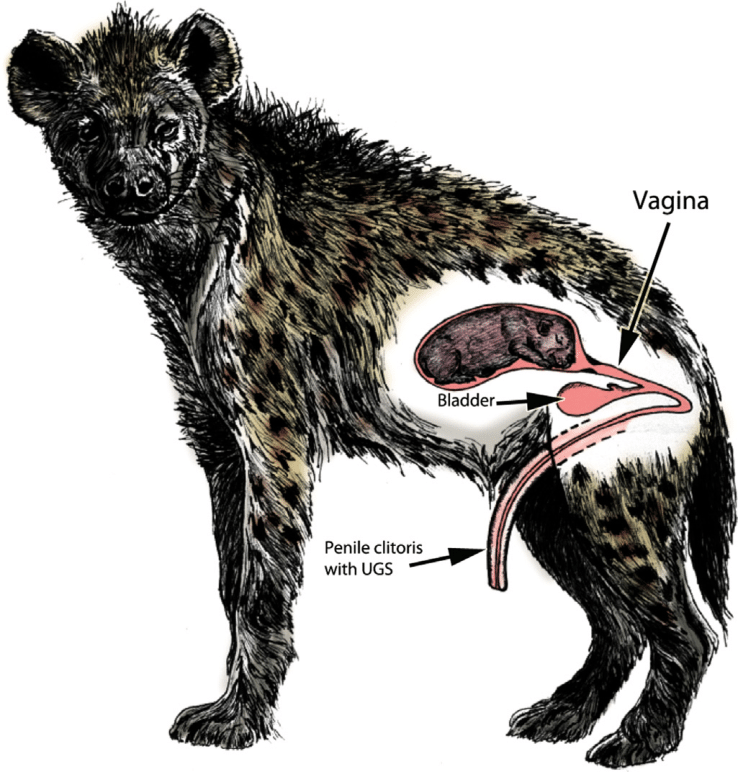Nature is full of fascinating and sometimes brutal adaptations, but few are as shocking as the birthing process of the spotted hyena. You might think childbirth is a universally painful experience, but hyenas take it to an entirely new level.
Female hyenas have one of the most unusual reproductive anatomies in the animal kingdom—what appears to be a penis is actually an elongated clitoris, known as a pseudo-penis. This rare adaptation makes mating, birth, and survival incredibly difficult for both mother and cubs.
Let’s dive into the science, struggles, and evolutionary mysteries behind why hyenas experience one of the most challenging births in the wild.
Hyenas’ Unique Reproductive Anatomy: A Bizarre Evolutionary Twist

The female spotted hyena (Crocuta crocuta) is unlike any other mammal when it comes to reproduction. Unlike most female mammals, hyenas have no external vaginal opening. Instead, their labia are fused together, forming a pseudo-scrotum, and their clitoris is elongated into what resembles a fully functional penis.
This means that both mating and giving birth happen through a narrow, tough, and inflexible canal—a structure that poses serious risks to both mother and cubs.
But why would evolution favor such an extreme adaptation? The answer lies in hyena social structure and dominance.
The Link Between Dominance and Reproductive Anatomy
Hyenas live in strict matriarchal societies, where females outrank males in dominance. The unusual reproductive anatomy is believed to be an evolutionary adaptation linked to social hierarchy.
- A Display of Strength: A larger pseudo-penis might act as a dominance signal, making it clear which females hold power in the clan.
- Hormonal Influence: Female hyenas have higher testosterone levels than males, leading to increased aggression and dominance over the pack.
- Mating Challenges: Males must earn the right to mate, as females control copulation with their complicated anatomy.
Video : Hyenas’ Brutal Birth: The Most Painful Labor in the Animal Kingdom
While this system gives females power, it comes at a terrible cost when it’s time to give birth.
Why Giving Birth Is So Dangerous for Hyenas
Imagine trying to push a newborn through a passage too small, too rigid, and highly prone to tearing. That’s exactly what female hyenas go through every time they give birth.
Here’s what makes hyena birth so deadly:
- A Super Tight Birth Canal
- The pseudo-penis acts as the only birth canal, but it is long, narrow, and lacks the elasticity of a normal vagina.
- This makes labor extremely difficult and painful, with a high chance of the tissue tearing.
- First-Time Mothers Face the Worst Risks
- Many first-time mothers do not survive the birthing process due to severe ruptures.
- Those who do survive often suffer from long-term damage to their reproductive organs.
- High Cub Mortality Rate
- A staggering 60% of hyena cubs suffocate before they are fully delivered.
- Since the birth canal is so tight, cubs often become trapped and die before they can emerge.
- A Painful Recovery Process
- After birth, the pseudo-penis often ruptures completely, forcing it to heal over time.
- Mothers suffer weeks of pain and vulnerability while their bodies recover.
Despite these brutal challenges, hyenas continue to thrive, and their unique reproductive system has remained largely unchanged for millions of years.
How Do Hyenas Mate? The Struggles of Reproduction

If you think birth is difficult for hyenas, mating is no easier. Males must overcome significant anatomical and social obstacles just to reproduce.
- Males Are Submissive to Females
- Unlike in many species where males dominate, male hyenas are the weaker sex in both power and ranking.
- They must approach females cautiously, often displaying submissive behavior to gain approval.
- Navigating the Pseudo-Penis
- Since females have no traditional vaginal opening, males must carefully maneuver through the pseudo-penis to copulate successfully.
- This requires both patience and precise positioning, making it one of the most complex mating processes in the animal world.
- Only the Strongest Males Get to Reproduce
- Males don’t fight each other for dominance like in other species. Instead, they must earn the female’s trust over time.
- Females choose mates based on persistence, patience, and respect, ensuring only the most determined males pass on their genes.

Given how dangerous and inefficient the reproductive process is for hyenas, one might wonder why evolution hasn’t corrected this issue.
The answer lies in survival strategy and social dynamics.
- Matriarchal Control Guarantees Stronger Cubs
- By limiting mating to only the most persistent males, female hyenas ensure that their cubs inherit strong genetics.
- This method prevents weaker genes from spreading, keeping the species robust.
- Higher Testosterone Helps With Survival
- The same high testosterone that makes birth difficult also makes female hyenas stronger and more aggressive.
- This aggression helps protect their cubs and maintain dominance in their environment.
- Fewer Cubs = More Resources
- Since many cubs don’t survive birth, the ones that do are often given more attention and resources.
- This ensures the strongest cubs make it to adulthood, increasing the clan’s overall survival rate.
The Resilience of the Spotted Hyena
Despite their brutal birthing process, hyenas have thrived for millions of years. Their ability to adapt, dominate, and survive proves just how powerful evolutionary trade-offs can be.
- They are among Africa’s most successful predators, competing with lions for food.
- Their clans are ruled by powerful females, ensuring only the strongest members survive.
- They have some of the most advanced social structures in the animal kingdom, making them highly intelligent and strategic.
Video : The Most Extreme Births In The Animal Kingdom
Conclusion: Nature’s Ultimate Test of Survival
Hyenas are proof that nature often prioritizes survival over comfort. Their unique reproductive anatomy, extreme birthing challenges, and dominance-driven society have allowed them to thrive despite overwhelming odds.
While their birth process remains one of the most painful and deadly in the animal kingdom, it also ensures that only the strongest females and cubs survive.
So the next time you see a spotted hyena, remember—they’re not just fierce scavengers. They’re survivors of one of evolution’s toughest reproductive challenges.
My Husband’s Cousin Came to Stay with Us Temporarily with Her Child – If Only I Had Known It Was All a Setup

When Derek’s cousin Daisy and her son arrive, it seems like an innocent favor. But strange comments, awkward glances, and hidden tension hint at a darker truth. Then comes the devastating revelation: Daisy isn’t his cousin, and Patrick isn’t his nephew. Shattered by betrayal and blindsided by lies, Rebecca is forced to unravel the secrets her husband tried to bury. Can trust survive a truth this explosive, or is it already too late?
When my husband told me his cousin Daisy and her son Patrick needed a place to stay for a couple of weeks, I didn’t think twice. He said they’d fallen on hard times and just needed a little help to get back on their feet.
“Of course,” I said. “Family is family.”

A woman and her son sitting on a couch | Source: Midjourney
I mean, really? Before Derek and I were married, I had financial issues, too. It had been a struggle and a half to get myself out of my study loan debt, among other things.
So, what would it say about me if I didn’t reach out to help my husband’s family?
That was a month ago. If only I knew how deeply those words would cut.

A woman sitting on a couch | Source: Midjourney
When Daisy and Patrick arrived, everything seemed fine. At first, Daisy was polite but reserved, and I chalked it up to shyness. She wasn’t particularly warm toward me, but toward Derek?
She was a different person altogether!
She was animated, laughing at his jokes and chatting like they’d known each other forever. I ignored the faint flicker of discomfort that rose in my chest.

A smiling woman | Source: Midjourney
They were family.
Right?
Patrick, though, was another story. At first, he was just an energetic eight-year-old. But within days, he turned into a whirlwind of chaos.

A little boy playing with his toys | Source: Midjourney
Crumbs littered the living room floor, sticky handprints appeared on the walls, and his toys became landmines scattered across the house.
The worst part?
He didn’t listen. I once asked him to clean up after himself, and he threw a tantrum, flinging cushions from the couch.
“You’re not my mother!” he shrieked. “I don’t listen to you!”
I finally had enough one evening.

An upset little boy | Source: Midjourney
“Patrick,” I said firmly, abandoning the light and caring attitude I wanted to initially use with him. “I need you to understand that you’re a guest here. Act properly. Behave. This isn’t your home.”
His reply made my stomach drop.
“No, Rebecca,” he said, spitting out my name. “My mom told me this is our home now.”
I stared at him, unsure if I’d heard him right.

A shocked woman | Source: Midjourney
Excuse me?
It had to be a misunderstanding, I told myself. Kids misinterpret things all the time, and Daisy probably said it to make the move easier on him.
But his words stayed with me, a tiny splinter in the back of my mind.
The real unraveling began a week later, during a casual lunch with Derek’s sister, Ashley. She’d come by to invite us to a family dinner, and the three of us were sitting outside, enjoying lemonade and plates of spaghetti. Daisy had taken Patrick for ice cream and a walk to the park.

A little boy holding an ice cream cone | Source: Midjourney
At some point, she turned to me with a warm smile.
“You’re a saint for letting them stay here, Becca,” she said.
I waved her off with a laugh, spearing a meatball with my fork.
“Stop it! It’s your family. How could I turn your cousin and nephew away? Why wouldn’t I let them stay?”

A plate of food | Source: Midjourney
Her fork froze midway to her mouth.
“Wait. So he didn’t tell you?” she gasped.
My chest tightened.
“Tell me what? Ash? Derek?”
Ashley’s eyes darted to Derek, who was suddenly very interested in his glass of lemonade.

A man sitting at a table | Source: Midjourney
“Oh, my god. Becca…” she whispered. “You really don’t know…”
“Know what?” My voice wavered as the splinter in my mind turned into a dagger.
Ashley’s face paled.
“Daisy isn’t our cousin, Becca,” she blurted out. “She’s Derek’s ex-girlfriend. And Patrick? He’s their son.”
The room tilted.

A shocked woman | Source: Midjourney
I had to grip hard onto the edge of the table to steady myself, my pulse pounding in my ears.
“What are you talking about?” I croaked, though deep down, I already knew the answer.
Ashley looked stricken.
“I thought you knew, Becca! Derek told the whole family he’d explained everything to you. Our mother told him that he had to tell you the truth before you got married. Daisy was raising Patrick with her then-boyfriend, but Derek was sending child support to them!”

A talking older woman | Source: Midjourney
She sighed deeply, remorse filling her lungs. I knew she hated being the one to tell me.
Then, her gaze snapped to him.
“You said you told her!”
Derek didn’t meet my eyes. My stomach churned as every odd moment from the past month clicked into place.

An upset woman | Source: Midjourney
Daisy’s reserved demeanor around me, her easy laughter with Derek, Patrick’s defiant declaration. I felt like the biggest fool on earth.
I stood abruptly, my chair scraping against the floor.
“You have to get back to work. I have to clean up here and log onto a meeting. I will be at your office in two hours. And you’re going to explain everything.”
Derek’s face clouded and then cleared. He nodded.

An upset man sitting at a table | Source: Midjourney
“Fine. I’ll push my meetings, Becs,” he said, leaving.
“I’m so sorry, Rebecca,” Ashley said, picking up the empty plates. “I truly thought that Derek was a man of his word.”
“It’s not your fault, babe,” I said. “This is on him. But I need you to know that whatever happens next has nothing to do with you. Okay?”
She nodded meekly and began to wash the dishes.

A woman busy at the sink | Source: Midjourney
At Derek’s office, I waited in a small conference room, my heart still hammering. When Derek walked in, he looked like he’d aged ten years in the span of an hour.
He sat across from me, his shoulders slumped.
“Start talking,” I demanded.
He exhaled shakily, avoiding my gaze.

A conference room | Source: Midjourney
“Yes, Daisy is my ex-girlfriend,” he admitted, his voice barely above a whisper. “And Patrick is my son.”
The words hit like a wrecking ball.
“You lied to me,” I said. “You looked me in the eyes and lied. You allowed me to set up the guest room, to turn my home office into a makeshift kid’s room? You watched all of that, and you didn’t think about telling me the truth?”

A cozy guest bedroom | Source: Midjourney
“I didn’t know how to tell you, Becca,” he stammered. “It was years before we met. Daisy and I broke up before Patrick was born. I’ve always supported him financially, but I kept my distance. When Daisy reached out, she said that she needed help. And I felt obligated. That’s my son, after all.”
“Obligated?” I spat. “You lied to me about who they are! You let me believe they were your cousin and nephew! Do you have any idea how humiliating this is?”
“I know,” he said, tears pooling in his eyes. “But I was scared. I thought it would push you away. I thought it would be easier this way. I’m sorry. I’ll tell Daisy and Patrick to leave tonight if that’s what you want.”

An upset woman | Source: Midjourney
His desperation might’ve softened me on any other day, but right then, it only made me angrier.
“They should’ve left the moment this charade started. You’ve disrespected me in every way possible.”
He didn’t try to argue.
“You’re right,” he whispered. “I’ll fix this.”
The next few days were excruciating.

An upset man | Source: Midjourney
Daisy avoided me entirely, and Patrick kept to his room, his usual chaos replaced by an eerie silence.
Derek threw himself into damage control, arranging for Daisy and Patrick to move into a rental while simultaneously begging for my forgiveness.
I confronted Daisy once, though.
“Why would you go along with this lie?” I demanded, watching her make her way through my kitchen while she made a sandwich.

A woman standing in a kitchen | Source: Midjourney
She flushed with shame, almost dropping the jar of mayonnaise.
“I didn’t want to lie,” she said softly. “But Derek thought it would be easier. I’m sorry. I never wanted to cause problems.”
Her apology didn’t heal the wound, but it clarified one thing for me:
This disaster was Derek’s making.

A jar of mayonnaise | Source: Midjourney
Once Daisy and Patrick moved out, the house felt unbearably quiet.
Derek tried everything to make amends. He left me notes apologizing for his lies, attended therapy on his own, and took on every household chore without being asked.
His remorse was evident, but my trust in him had been shattered.

A man busy in the kitchen | Source: Midjourney
It took weeks of reflection, long conversations with my best friend, Sharon, and more than a few sleepless nights before I made my decision.
“Just know what you’re getting into, Becca,” Sharon said, stirring her matcha latte. “I’ll support you, of course, but please, think about it from all sides.”
One evening, I called Derek into the living room. He sat across from me, his face tense with anticipation.

A matcha latte | Source: Midjourney
“I’m not ready to forgive you, D,” I began, my voice steady. “But I’m willing to try.”
Relief washed over his face, but I held up a hand.
“This is your last chance, Derek,” I said firmly. “No more lies. No more half-truths. If you want this marriage to survive, you have to earn back my trust.”
“I will,” he said, his voice thick and heavy. “I promise.”

A woman sitting on a couch | Source: Midjourney
Rebuilding our marriage won’t be easy, and part of me wonders if it’s even possible.
But for now, I’m taking it one day at a time. I’ve learned one thing through all of this. Trust isn’t something you can take for granted.
It’s fragile.
As for Derek? He’s on thin ice. And if he thinks I’ll ignore the warning signs ever again, he’s dead wrong.
So now, I have to figure out how to be a stepmother.

A close up of a couple | Source: Midjourney
If you’ve enjoyed this story, here’s another one for you. When Alicia and Matt’s Christmas holiday trip to Jamaica is canceled due to his father’s open-heart surgery, they decide that spending time with the family is more important. Weeks later, Nancy, Matt’s mother, promises the couple a gift… only to take it back later and replace it with something unexpected.
This work is inspired by real events and people, but it has been fictionalized for creative purposes. Names, characters, and details have been changed to protect privacy and enhance the narrative. Any resemblance to actual persons, living or dead, or actual events is purely coincidental and not intended by the author.
The author and publisher make no claims to the accuracy of events or the portrayal of characters and are not liable for any misinterpretation. This story is provided “as is,” and any opinions expressed are those of the characters and do not reflect the views of the author or publisher.



Leave a Reply